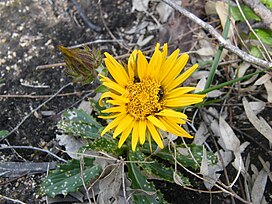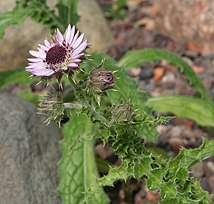Berkheya
| Berkheya | |
|---|---|

| |
| Berkheya sp. | |
| Scientific classification | |
| Kingdom: | Plantae |
| Clade: | Tracheophytes |
| Clade: | Angiosperms |
| Clade: | Eudicots |
| Clade: | Asterids |
| Order: | Asterales |
| Family: | Asteraceae |
| Subfamily: | Vernonioideae |
| Tribe: | Arctotideae |
| Subtribe: | Gorteriinae |
| Genus: | Berkheya Ehrh. |
| Synonyms[1] | |
| |
Berkheya is a genus of flowering plants in the family Asteraceae. It is distributed in tropical Africa, especially in southern regions.[2] Of about 75 species, 71 can be found in South Africa.[3]
Most species have yellow ray florets, a few have white, and B. purpurea has light purple or mauve florets.[2]
Berkheya purpurea is cultivated as an ornamental plant.[2] Some Berkheya are known as weeds.[4]
Berkheya coddii is a well-known hyperaccumulator. Concentration of Ni as the leaves of this species may reach 7.6% DW Ni.
The genus was named in honor of the Dutch scientist and artist Johannes le Francq van Berkhey.[5]
Berkheya are associated with a variety of weevils in the genus Larinus. The tephritid fruit fly Urophora agromyzella is also found on the plants.[4]
Species[edit]
- Berkheya acanthopoda
- Berkheya angusta
- Berkheya angustifolia
- Berkheya annectens – thistle-thorn
- Berkheya armata
- Berkheya barbata
- Berkheya bergiana
- Berkheya bipinnatifida
- Berkheya caffra
- Berkheya canescens
- Berkheya cardopatifolia
- Berkheya carduoides
- Berkheya carlinifolia
- Berkheya carlinoides
- Berkheya carlinopsis
- Berkheya chamaepeuce
- Berkheya cirsiifolia
- Berkheya coddii
- Berkheya coriacea
- Berkheya cruciata
- Berkheya cuneata
- Berkheya debilis
- Berkheya decurrens
- Berkheya densifolia
- Berkheya discolor
- Berkheya draco
- Berkheya dregei
- Berkheya echinacea
- Berkheya eriobasis
- Berkheya erysithales
- Berkheya ferox
- Berkheya francisci
- Berkheya fruticosa
- Berkheya glabrata – yellow thistle
- Berkheya griquana
- Berkheya herbacea
- Berkheya heterophylla
- Berkheya insignis
- Berkheya latifolia
- Berkheya leucaugeta
- Berkheya mackenii
- Berkheya macrocephala
- Berkheya maritima
- Berkheya montana
- Berkheya multijuga
- Berkheya nivea
- Berkheya onobromoides
- Berkheya onopordifolia
- Berkheya pannosa
- Berkheya pauciflora
- Berkheya pinnatifida
- Berkheya purpurea – purple berkheya
- Berkheya radula
- Berkheya radyeri
- Berkheya rhapontica
- Berkheya rigida – Augusta thistle, Hamelin thistle
- Berkheya robusta
- Berkheya rosulata
- Berkheya seminivea
- Berkheya setifera
- Berkheya speciosa
- Berkheya sphaerocephala
- Berkheya spinosa
- Berkheya spinosissima
- Berkheya subulata
- Berkheya tysonii
- Berkheya umbellata
- Berkheya viscosa
- Berkheya zeyheri
Phylogeny[edit]
Comparison of DNA has indicated that Berkheya in its current composition is paraphyletic because some of its species are more related to Cullumia, Cuspidia, Didelta and Heterorhachis than all species currently recognised as Berkeya among each other.[8]
Gallery[edit]
References[edit]
- ^ "Berkheya". Plants of the World Online. Royal Botanic Gardens, Kew. Retrieved 7 June 2022.
- ^ a b c Hind, N. (2006). 568. Berkheya purpurea. Archived 2016-03-04 at the Wayback Machine Curtis's Botanical Magazine 23(4), 289-96.
- ^ Funk, V. A. and R. Chan. (2008). Phylogeny of the spiny African daisies (Compositae, tribe Arctotideae, subtribe Gorteriinae) based on trnL-F, ndhF, and ITS sequence data. Molecular Phylogenetics and Evolution 48(1), 47-60.
- ^ a b Clark, M. M. A comparison between the flower-head insect communities of South African Berkheya and European Cynareae. In: Proceedings of the VIII International Symposium on Biological Control of Weeds. (pp. 165-170). Istituto Sperimentale per la Vegetale, Ministero dell'Agricoltura e delle Foreste. 1990.
- ^ Quattrocchi, Umberto (2017). CRC World Dictionary of Plant Names: Common Names, Scientific Names, Eponyms, Synonyms, and Etymology. Routledge.
- ^ Berkheya. The Plant List.
- ^ Species listing: Berkheya. Red List of South African Plants. South African National Biodiversity Institute (SANBI).
- ^ Phaliso, Ntombifikile; McKenzie, Robert James; Netnou-Nkoana, Noluthando C.; Karis, Per Ola; Barker, Nigel P. (2016). "Reassessing taxonomic relationships in the Berkheya clade (Asteraceae, Arctotideae-Gorteriinae): The utility of Achene morphology". Phytotaxa. 246 (1): 1–22. doi:10.11646/phytotaxa.246.1.1. hdl:2263/56371.




